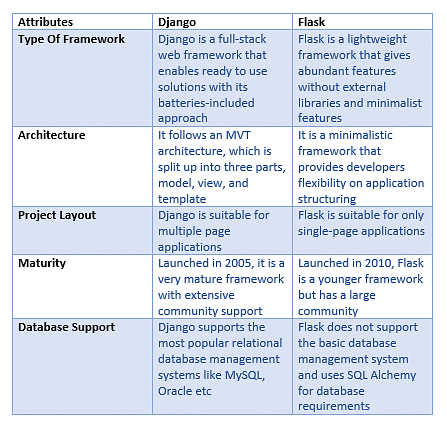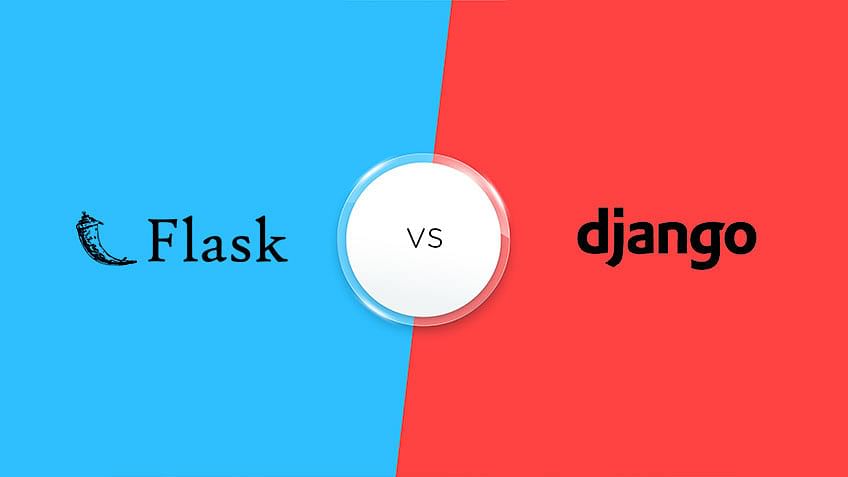Python is most commonly associated with data science and analysis. But it can also be used to build powerful web applications. You may have heard of Flask and Django, two Python frameworks for developing web applications. In this tutorial, you will learn both the frameworks and the major points in Django Vs. Flask framework.
A Brief Python Overview
Here is how the Python Software Foundation, the organization behind Python, sums up the language: “…an interpreted, object-oriented, high-level programming language with dynamic semantics. Its high-level built-in data structures, combined with dynamic typing and dynamic binding, make it very attractive for Rapid Application Development, as well as for use as a scripting or glue language to connect existing components together.”
Python was the second most popular programming language by the conclusion of 2020, taking Java’s place but still lagging behind C. Python appeals to beginning and veteran programmers, as well as non-programmers. Python is the language preferred by many data scientists, web developers, and software programmers, thanks to its easy-to-use syntax and versatility as a general-purpose programming language.
What is a Framework?
The framework is a set of modules that aid developers in writing web application code. It's a fully functional package that makes web development easier, faster, scalable, and dependable.
Frameworks written in the Python programming language include Django and Flask. According to the Developers Survey 2018, these python-based frameworks are one of the most popular frameworks for web development.
Why Frameworks Matter
Inevitably, you will encounter many tedious and repetitive tasks when working on Python projects like building a web application. These tasks include building back-end logic, designing a user interface, and hooking the app up to the internet so it interacts with a browser better. Web frameworks are designed to implement the functionalities commonly found in web applications, such as mapping URLs to Python code pieces.
But each framework offers different benefits. Let’s explore Flask vs Django.
What Is Django?
Django is a free programming language with improved features and performance. Django is preferred by developers because it allows them to use it for standard functions with minimal interference from systems, protocols, and management.
Django is also known as a 'framework for fussbudgets with deadlines,' because it promotes rapid development and clean, pragmatic design. The framework's agile development process focuses solely on delivering quality in a timely and efficient manner. Site maps, content organization, client information, and many other basic development functions are handled quickly by Django. It only cares about completing the application as soon as possible.
Adrian Holovaty and Simon Willison, two web developers, created Django in 2003. Django was born when they started making web applications with Python. It was finally made public two years later.
Django is named after Django Reinhardt, a well-known early and mid-century Belgian-Romani jazz guitarist.
Features of Django
- It's a flexible framework that can be used to build any website (social network, news site, content management system, and so on) with content in HTML, XML, JSON, and other formats. It can be used in conjunction with any client-side framework.
- It's a safe framework that handles things like user account management, transaction management, cross-site request forgery, clickjacking, and more automatically.
- One of the reasons Django is so popular for large web applications is that it is designed to handle high traffic demands.
- Django, as a full-stack Python framework, includes a wide range of features for your web app, from user authentication to RSS feeds.
Companies Using Django
There are some big companies that use Django for their website. Some of the companies are:
- Udemy
- Coursera
- Zapier
Disadvantages of Django
- Django has compatibility issues with the rest of the technologies
- The code size is often large
- Allows you to only handle one request at a time
What Is Flask?
Flask is another Python-based microframework for developing web applications. Armin Ronacher introduced it in 2011 as a test method for combining two solutions: Werkzeug (a server framework) and Jinja2 (a template library).
It was supposed to be a test run in a zip file that eventually stems from Flask's positive influence.
Because it does not rely on external libraries to perform framework tasks, Flask is classified as a micro framework. It has its own set of tools, technologies, and libraries to help with web application development.
Many developers prefer to start with Flask because it is more independent and flexible.
Features of Flask
- Flask is more adaptable to different working styles and approaches to web app development than the opinionated Django framework. Flask is preferred by programmers with more coding experience or who require more control over the app design.
- Flask supports multiple types of databases by default because it has no default model. This also simplifies the integration of databases into Flask applications.
- Flask will make your life easier than Django if you're looking to create a simple web app with a few static pages. Many programmers find Flask to be easily scalable for smaller web applications.
- It comes with a built-in development server and fast debugger.
Companies Using Flask
These are the companies that use Flask:
- Netflix
- Lyft
- Zillow
- MailGui
Disadvantages of Flask
- In comparison to Django, it provides limited support and has a smaller community.
- Larger implementations require more complicated maintenance.
Flask vs Django- Similarities
Both Flask and Django are open-source web frameworks used for Python. Both have well-established, mature use communities, are popular and widely supported, and offer developers a way to increase their programming productivity.
And the only way you can use either of these frameworks is to learn Python, of course.
Python Flask Vs. Django: The Difference in Detail
Let’s see some of the major differences between Django Vs. Flask

When Should You Use Flask or Django?
You will now see why you should choose one over the other now that you know the differences between Flask and Django and what each is used for.
You should use Django when:
- You are working on a large project and deadlines are the deciding factor.
- You want to scale up to a more complex task later on.
- You need an active online community and support.
- When you want to create web apps with ORM support, API backends, and future plans to incorporate high-end technologies like Machine Learning.
You should use Flask when:
- You are working on smaller projects with coding flexibility.
- You need API support and want to include more extensions in the future.
- You want more control over your database.
- Flask is the best choice for creating static websites, rapid prototypes, MVPs, and RESTful web services.
Conclusion
After reading and comprehending the in-depth information about both web frameworks, it is easy to conclude that they have their own advantages. There must be a reason why both are popular python-based frameworks in the web development domain.
Flask provides complete control and is ideal for small projects that require experimentation.
Django is a complex framework that requires extensive knowledge, but it is one of the best for developing sophisticated applications.
If you’re interested in becoming a Python programmer, Simplilearn has the resources to help on your way. Simplilearn’s Python course covers the fundamentals of Python and how to apply it to real-world applications. The modules, lesson-end projects, and assignments comprising the curriculum cover data operations in Python, strings, conditional statements, error handling, shell scripting, web scraping, and the commonly used Python web framework, Django.
Once you complete the course, you gain certification in an essential skill for success in today’s IT world. Many IT-related careers rely on a solid knowledge of different programming languages, which is why it’s a smart idea to learn Python for Data Science, for example.
Python developers in the United States can earn an annual average salary of USD 110,447, according to Indeed. The site further points out that in India, the average Python developer salary averages around ₹566,019.
But wait, there’s more! Simplilearn also offers a Data Science with Python course. The course teaches you to master the concepts of Python programming. Through this, you will gain knowledge in data analysis, machine learning, data visualization, web scraping, and natural language processing. When you successfully complete the course, you will have mastered the essential tools of Data Science with Python.
Have any questions for us regarding this article? If yes, please leave them in the comments section, and we will get back to you as soon as possible.
Happy learning!

